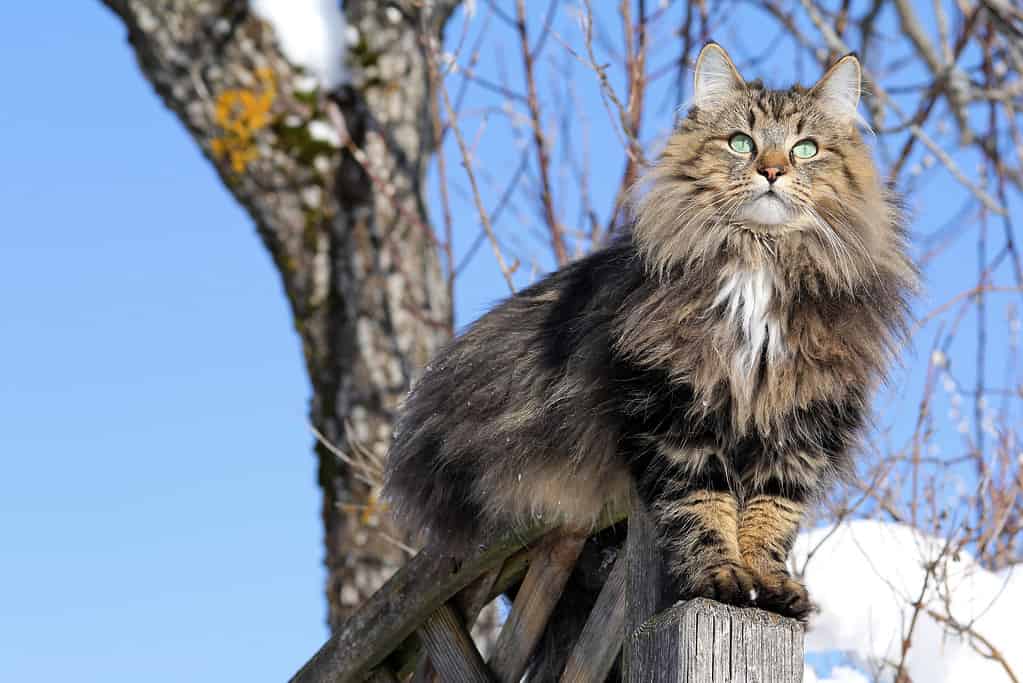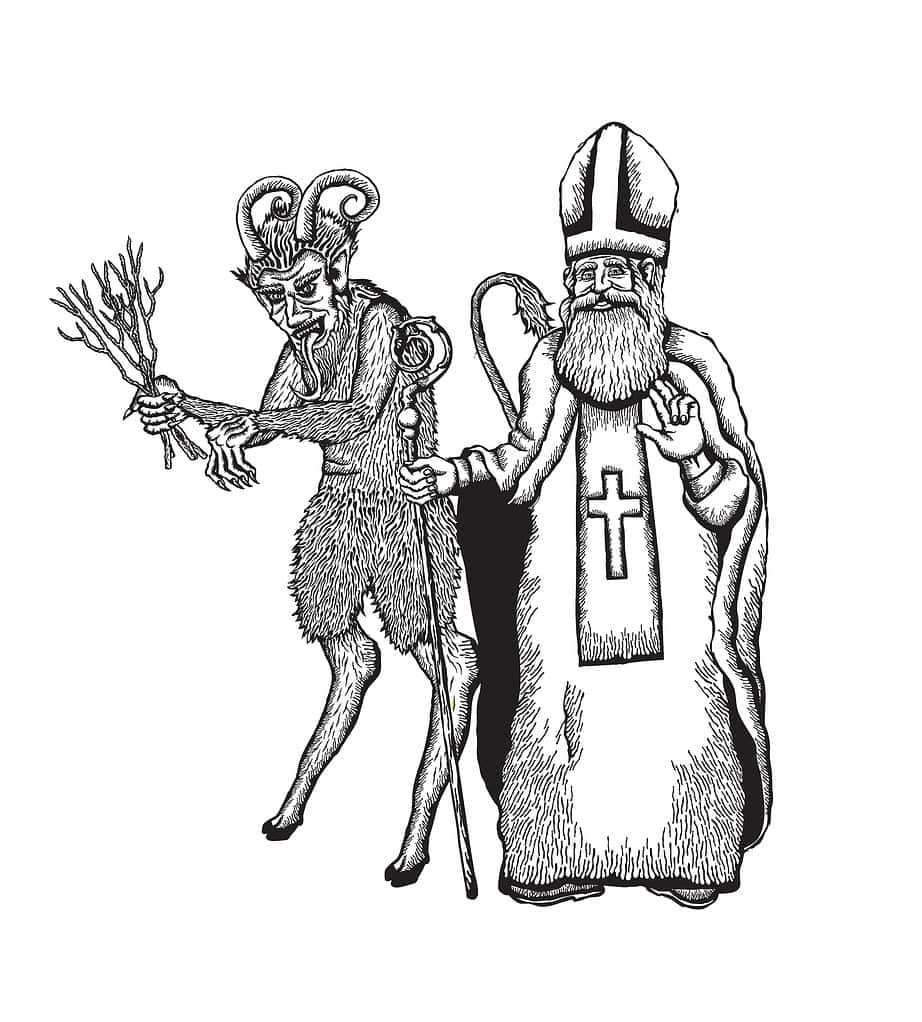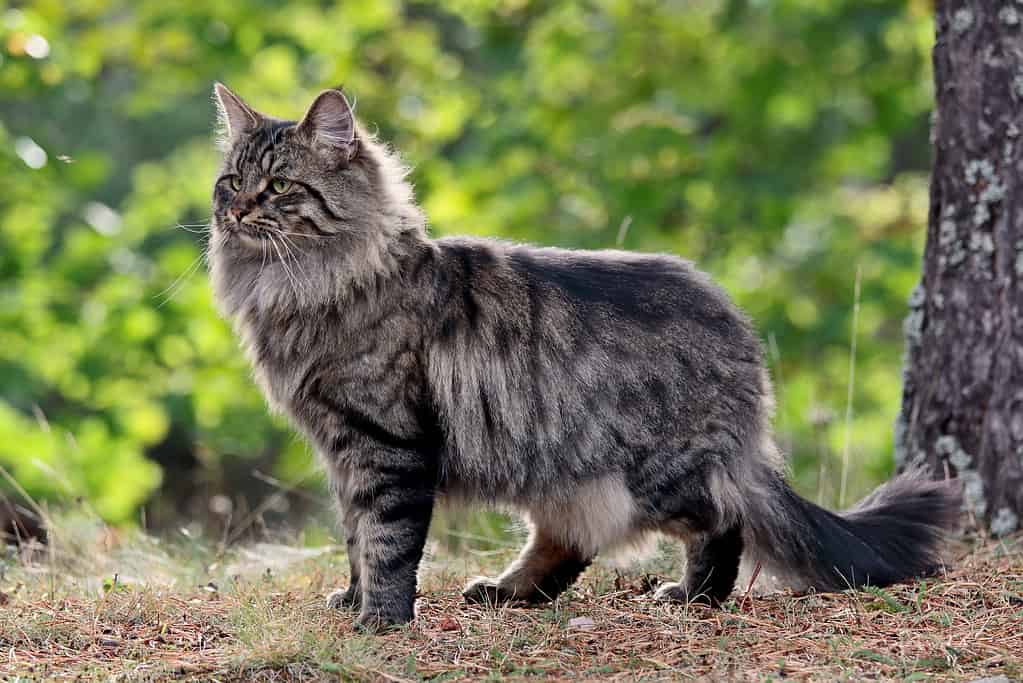
Cats love playing with low hanging ornaments on a tree in an attempt to understand their purpose.
©Anna-av/iStock via Getty Images
Christmas time comes with a plethora of wonderful folktales and spiritual beings from around the world. They range from jolly saints to magical creatures, antagonistic chimeras, and mischievous pranksters. Everyone knows the story of Santa Claus and his elves, and recent stories are making Krampus a common household name.
But one figure lurking in the shadows is rarely talked about. The Yule Cat is a popular figure in Iceland that influences how families buy presents. It’s a creature you do not want to see during the holidays.
What is the Yule Cat

The Yule Cat is a monster, house-sized cat that stalks Icelandic locals during Christmas.
©Midjourney AI; prompted and modified by Triton, CC BY 4.0, via Wikimedia Commons – License
Jólaköttur is a massive black cat that sleeps in the snowy mountains near Iceland. Its name is a translation combining the words “Jól” (yule) and “köttur” (cat). The Yule cat is said to be several feet tall, nearly the size of a house, and moves so quietly through the snow that no one can hear it.
The earliest reports of the Yule Cat date back to the Dark Ages when people struggled to stay warm with minimal food and clothing. Unfortunately, due to poor literacy at the time, direct mentions of the Yule Cat did not become popular until the 19th century.
The Yule Cat of today is based on an Icelandic poem called “The Christmas Cat,” by Johannes ur Kotlum in 1932.
Legends of the Yule Cat

Norwegian Forest cats are excellent pets because they love to snuggle and socialize with their family.
©Astrid Gast/iStock via Getty Images
According to legend, the Yule Cat stays in the snowy mountains and countryside until Christmas time. On Christmas Eve, the Yule cat quietly stalks through the local towns, peering into windows to see if families and children receive new clothes.
If they have new clothes, the Yule Cat will leave the family alone and continue its journey.
If they do not have new clothes, the Yule Cat will leap through the window and attack. The Yule Cat may eat their victims or viciously maul them.
Origins of the Yule Cat
Like all sources of folklore, the origin of the Yule Cat comes from different points in time.
Dark Ages Survival

It was common for families to wear down clothing throughout the year because they had few choices.
©Анатолий Тушенцов/iStock via Getty Images
During the Dark Ages, it was difficult to keep workers motivated and everyone safe with little food, poor shelters, and few articles of clothing.
During the holiday seasons, dedicated workers would be rewarded with extra food and new clothing to help them survive. Workers who did a poor job were not given new clothing and were susceptible to falling ill when the temperature dropped.
Parenting Children

Certain parts of Germany tell how Krampus and Santa work together to reward or punish children.
©Darko Mlinarevic/iStock via Getty Images
Families around the world use fear as a tactic to teach children. Parents in Northern Europe taught their children that if they were good and behaved all year, they would be rewarded with new clothes to replace old garments.
However, if the children misbehaved, they would not receive new clothing. To enhance the argument, a giant ferocious cat was added to the mix.
Krampus and legends of a “boogeyman” are all similar tactics to scare children into obeying to their parents. Additionally, these antagonistic beings reinforce the idea that working hard will lead to positive rewards.
What Type of Cat is the Yule Cat

Their unique coloring mimics tree bark, camouflaging them from predators.
©undefined undefined/iStock via Getty Images
The Yule Cat is obviously fictional, but it is inspired by a real-life cat in the region.
The Norwegian Forest cat is one of the largest cat breeds in the world. They can weigh up to 22 pounds and have a double-layer coat to protect them from the extremely cold weather. These cats love climbing trees and hunting small prey like birds and rodents.
The breed almost went extinct due to over-cross breeding with domestic cats but was saved by dedicated breeding programs. As of 1938, it is the official cat of Norway.
Norwegian Forest cats are exceptionally large and fluffy cats that can move through the snow quietly and stalk without anyone knowing. Through creative embellishment, the Yule Cat can easily become a monster-sized Norwegian Forest cat.
Additionally, Norwegian Forest cats have a history in folklore. In Norse mythology, two Norwegian Forest cats pull Freya’s chariot. Freya is the Goddess of love, fertility, beauty, and magic.
Modern Yule Cat Activities

Norwegian Forest cats have thick fur that keeps them comfortable in sub-freezing temperatures.
©Astrid Gast/Shutterstock.com
Today, the Yule Cat is a popular folklore in certain areas of the globe, and remnants of its teaching remain in the Christmas spirit.
It is common to give families clothes for Christmas. Though modern children tend to be disappointed with new clothes instead of toys, games, or upgraded technology, The Yule Cat promotes gratitude for these practical gifts.
In 2018, the city of Reykjavik placed a 16-foot Yule Cat statue in the town square to honor the legend. The placing of the statue is now an annual tradition. Families and tourists gather to take photos and exchange gifts of clothing to appease the monster feline.
The photo featured at the top of this post is © Elisa Putti/Shutterstock.com
Thank you for reading! Have some feedback for us? Contact the AZ Animals editorial team.






